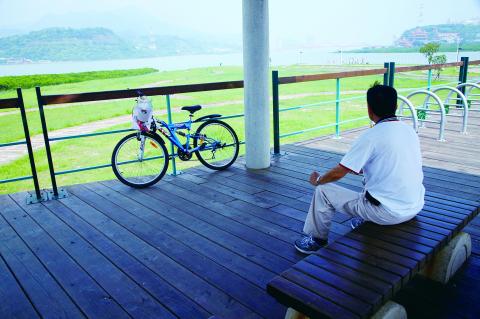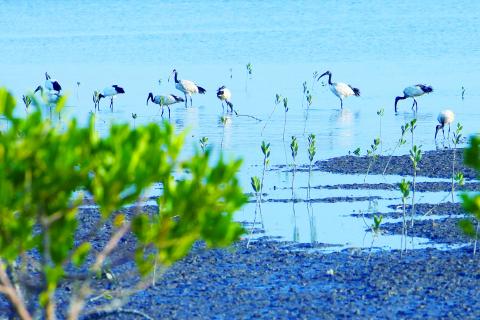The Shezihdao peninsula, located where the Keelung River and the Tamsui River converge, used to be associated with flooded streets during typhoon seasons. After its embankment was built, the peninsula has gradually rid itself of its flooding problem, and it is now becoming a popular leisure destination. Today, Shezihdao is almost unrecognizable.
Although Shezihdao Daotou Park is only one hectare in size, there is much more to do here than you might think. The tip of this peninsula is reclaimed land, using infill obtained when the Taipei City Government dredged the Keelung River. The bank is covered in a carpet of lush green. Stone and wooden walkways provide visitors with a comfortable path to the viewing pavilion built there. The pavilion is usually packed with anglers, and is itself a perfect spot to take in the panorama of the convergence of the Keelung River and the Tamsui River. Looking straight ahead from the pavilion affords you a spectacular 270-degree view of the river. Turning to the right, you can see Guandu Temple, which is always filled with worshipers, and the Guandu Bridge, with its blazing red color. Left of that, and in the distance, is the majestic Guanyin Mountain, the view now and then interrupted by little egrets swooping down, giving an effect reminiscent of a beautiful landscape painting. To the left of the pavilion is the dense Hongshulin mangrove swamp, echoing the Guandu Nature Park wetland across the river. If you’re fortunate, after the tide recedes, you might even see fiddler crabs surfacing in the wetland, contributing to a veritable symphony of mangrove ecological life.
Perhaps the best means of transportation into the park is by bicycle. There is a bike path on the top of the embankment surrounding the peninsula, which, if compared with other bike paths in Taipei, is raised, making it almost feel like you are biking along a mountain ridge. The view is spectacular, with distinctly different views on both sides of the embankment. The left-hand side gives you a panoramic view of the river, while the right-hand side offers you the village view of the peninsula. Biking there is a breeze.

Photo: Wang Neng-you, Department of Information and Tourism, Taipei City Government
Photo: Wang Neng-you, Department of Information and Tourism, Taipei City Government
Source: Wang Yi-yen, Department of Information and Tourism, Taipei City Government, originally in the Taipei Pictorial, edition 501.
(Translated by Ethan Zhan, Taipei Times)
位於基隆河與淡水河交會處的社子島,早年總是給人每逢颱風季必淹水的印象,但是近年來隨著堤防工程完工,社子島不但已逐漸擺脫水患之苦,還蛻變成一處休閒勝地,今日的社子島已不可同日而語!

Photo: Wang Neng-you, Department of Information and Tourism, Taipei City Government
照片:王能佑,臺北市政府觀光傳播局《台北畫刊》第501期
社子島島頭公園面積雖僅一公頃,但是大有看頭。此島頭乃是臺北市政府利用基隆河疏濬的土方所填出來的灘地,灘地上綠草如茵,並闢建出石板路與木棧道,方便民眾親近觀景平台。觀景平台總是擠滿了垂釣客,這裡也是觀賞基隆河與淡水河交會及入海的絕佳地點,放眼望去,是270度的壯闊河景,朝右望去有香火鼎盛的關渡宮、氣勢如紅的關渡大橋,往左看遠方有巍峨雍容的觀音山,其間不時有小白鷺飛掠點綴,好一幅寫意的山水畫!平台左手邊是茂密的紅樹林濕地,與對岸的關渡自然公園濕地相呼應,退潮後的濕地還可看到探出頭的招潮蟹,共譜一曲紅樹林生態交響曲。
到社子島島頭公園最好的交通工具是騎自行車。社子島利用堤頂建設環岸自行車道,與臺北市其他自行車道相較,這裡的車道高於地面的車道,像是騎在稜線上,擁有寬闊的視野,堤岸兩邊景色迥異,左岸是寬廣的河景,右岸則是社子的村莊聚落,騎來格外怡然自得。
文/王宜燕,臺北市政府觀光傳播局《台北畫刊》第501期(台北時報記者詹豐造英譯)

In an effort to fight phone scams, British mobile phone company O2 has introduced Daisy, an AI designed to engage phone con artists in time-wasting conversations. Daisy is portrayed as a kindly British granny, exploiting scammers’ tendency to target the elderly. Her voice, based on a real grandmother’s for authenticity, adds to her credibility in the role. “O2” has distributed several dedicated phone numbers online to direct scammers to Daisy instead of actual customers. When Daisy receives a call, she translates the scammers’ spoken words into text and then responds to them accordingly through a text-to-speech system. Remarkably, Daisy

Bilingual Story is a fictionalized account. 雙語故事部分內容純屬虛構。 Emma had reviewed 41 resumes that morning. While the ATS screened out 288 unqualified, she screened for AI slop. She could spot it a mile away. She muttered AI buzzwords like curses under her breath. “Team player.” “Results-driven.” “Stakeholder alignment.” “Leveraging core competencies.” Each resume reeked of AI modeling: a cemetery of cliches, tombstones of personality. AI wasn’t just changing hiring. It was draining the humanity from it. Then she found it: a plain PDF cover letter. No template. No design flourishes. The first line read: “I once tried to automate my

Every May 1, Hawaii comes alive with Lei Day, a festival celebrating the rich culture and spirit of the islands. Initiated in 1927 by the poet Don Blanding, Lei Day began as a tribute to the Hawaiian custom of making and wearing leis. The idea was quickly adopted and officially recognized as a holiday in 1929, and leis have since become a symbol of local pride and cultural preservation. In Hawaiian culture, leis are more than decorative garlands made from flowers, shells or feathers. For Hawaiians, giving a lei is as natural as saying “aloha.” It shows love and

1. 他走出門,左右看一下,就過了馬路。 ˇ He walked outside, looked left and right, and crossed the road. χ He walked outside and looked left and right, crossed the road. 註︰並列連接詞 and 在這句中連接三個述語。一般的結構是 x, y, and z。x and y and z 是加強語氣的結構,x and y, z 則不可以。 2. 他們知道自己的弱點以及如何趕上其他競爭者。 ˇ They saw where their weak points lay and how they could catch up with the other competitors. χ They saw where their weak points lay and how to catch up with the other competitors. 註:and 一般連接同等成分,結構相等的單詞、片語或子句。誤句中 and 的前面是子句,後面是不定詞片語,不能用 and 連接,必須把不定詞片語改為子句,and 前後的結構才相等。 3. 她坐上計程車,直接到機場。 ˇ She took a cab, which took her straight to the airport. ˇ She took a cab and it took her straight